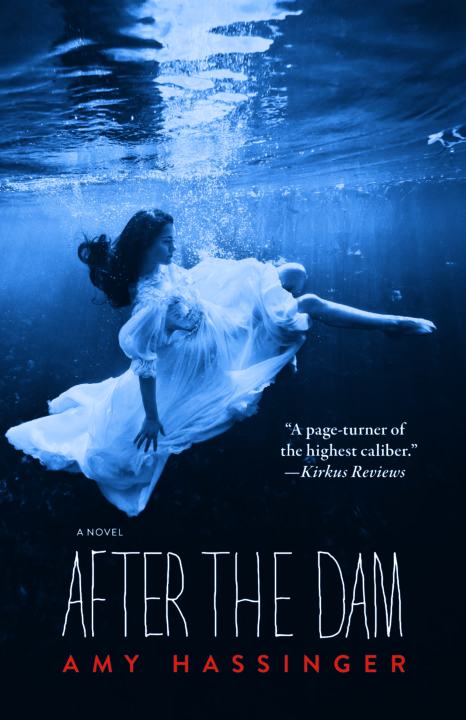
AFTER THE DAM
Undone by motherhood, judged by her husband, thirty-two-year-old Rachel Clayborne flees with her baby in the middle of the night for the one place on earth that’s been her refuge: her grandmother’s lakehouse in northern Wisconsin. Hoping to reconnect with a former, healthier self, she instead faces a confused and dying grandmother, her ever-present nurse who seems bent on thwarting each of Rachel’s desires, and a changed ex-boyfriend—her first and most passionate love. As a constant rain threatens the nearby dam, Rachel struggles to discern what’s happened to the past, who she’s become, and what kind of a life she will make for herself now—one that clings to ghosts or opens bravely to a wild new geography.
Undone by motherhood, judged by her husband, thirty-two-year-old Rachel Clayborne flees with her baby in the middle of the night for the one place on earth that’s been her refuge: her grandmother’s lakehouse in northern Wisconsin. Hoping to reconnect with a former, healthier self, she instead faces a confused and dying grandmother, her ever-present nurse who seems bent on thwarting each of Rachel’s desires, and a changed ex-boyfriend—her first and most passionate love. As a constant rain threatens the nearby dam, Rachel struggles to discern what’s happened to the past, who she’s become, and what kind of a life she will make for herself now—one that clings to ghosts or opens bravely to a wild new geography.
From the acclaimed author of Nina: Adolescence and The Priest’s Madonna comes a gripping new novel that depicts the transformative power of motherhood with honesty, wit, and compassion.
- Red Hen Press
- Paperback
- September 2016
- 344 Pages
- 9781597097536
About Amy Hassinger
Amy Hassinger is the author of two previous novels: Nina: Adolescence and The Priest’s Madonna. Her writing has been translated into five languages and has won awards from Creative Nonfiction, Publisher’s Weekly, and the Illinois Arts Council. Her work has appeared in numerous venues, including The New York Times, Creative Nonfiction, The Writers’ Chronicle, and The Los Angeles Review of Books. She is a graduate of the Iowa Writers’ Workshop and teaches in the University of Nebraska’s MFA in Writing Program.
Praise
“Taut, beautifully written, and suspenseful, this resonant, feminist drama eschews easy answers. A page-turner of the highest caliber.”—Kirkus Reviews (starred review)
“This book does what my favorite books always do: grab the reader with tautness and fierce intelligence, so that even the quiet drama of it gets pulled into the page-turning qualities of the narrative. I could say, Read this book. Instead I’ll say, Start this book. You won’t stop reading until its terrific ending.”—Leigh Allison Wilson, author of Wind and From the Bottom Up
“Forces of nature—big water and big love—come together in this unforgettable literary page-turner. Amy Hassinger has woven a tale out of the very earth where the Ojibwe live. Her protagonist—Rachel—is a lover, mother, and activist, a woman of our time on a hero’s journey toward wholeness.”—Patricia Henley, author of Hummingbird House, finalist for the National Book Award
“After the Dam begins with a phone call’s unexpected news, a young mother’s drive through the night with her infant in tow, and then the arrival at a family farm that offers multiple hidden pasts and more than one future. With an impressive empathetic skill, Amy Hassinger guides her conflicted characters through a complex path where personal regret and longing confront and echo the moral dilemmas of our country’s troubled history. This is a brave and beautifully written novel, one that offers quiet wisdom and no easy answers.” —Philip Graham, author of The Moon, Come to Earth
Discussion Questions
1. Rachel leaves home with her baby Deirdre in the middle of the night, as if she’s escaping something. What is she escaping? What does she hope to find at the Farm? Does she find it or not, by the end of the book?
2. Mothers appear throughout the novel, in different forms. Identify five different mother figures in the book, and discuss each of them. Which representations are positive? Which are negative? Which are mixed? Is the novel making a statement about motherhood? What might that be, if so?
3. Michael urges Rachel to see a therapist for what he believes might be post-partum depression. Rachel resists this. Who’s right? Why?
4. Rachel and Diane come into conflict with one another over the course of the novel. Why are they fighting and what are they fighting over? How does each of them approach the conflict? Do you identify more with one character or the other? Why?
5. Setting is a crucial element in After the Dam, most especially the motifs of water, woods, and the eagles. How do these motifs function in the novel? What associations do they take on as the story progresses?
6. Both the Old Bend Dam and the Farm are central symbols in the book. What does each thing represent to Rachel? To Joe? To Diane? To Maddy? Does this change by the end of the book? How?
7. Does the novel present a convincing argument for the removal of dams? Why or why not?
8. At one point in the book, Joe tells Rachel, “You can’t go back.” And yet he spends much of his time searching under the reservoir for a lost world, longing—arguably—for the past. How do you reconcile this? Is Joe living in the past? The present? The future? Does this change over the course of the book?
9. One of the novel’s epigraphs is a quote from the scholar Cornel West: “Justice is what love looks like in public.” What connection do you see between the quote and the novel’s themes?
10. The novel’s ending leaves much to readers’ imaginations. What do you think happens beyond the last page? What will Rachel’s life look like in five years? Joe’s? Diane’s? Michael’s?
